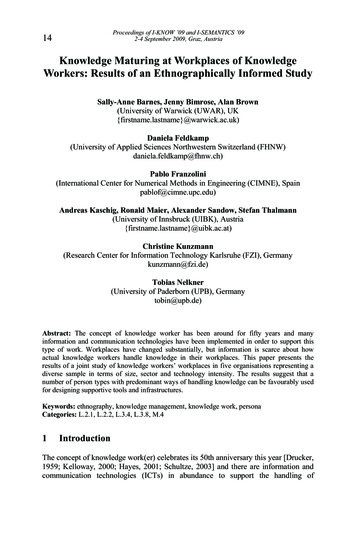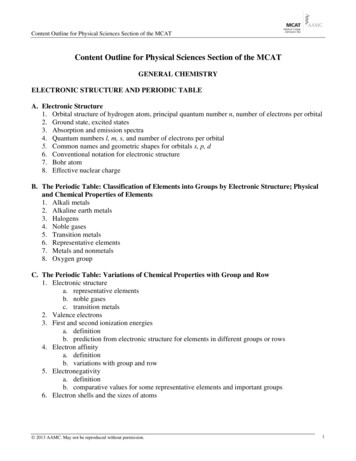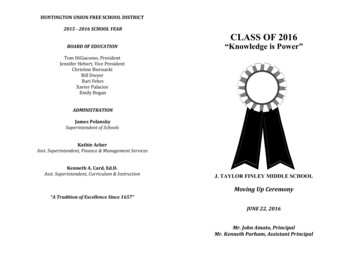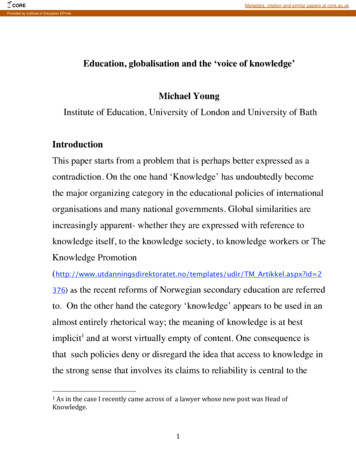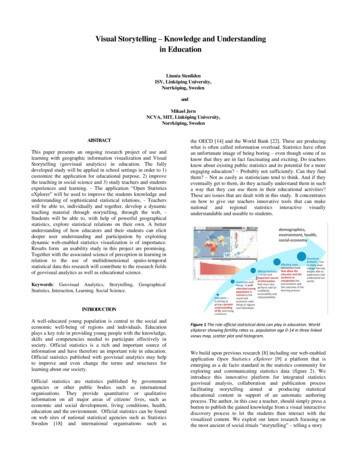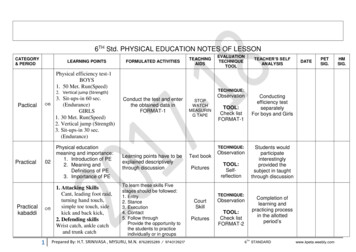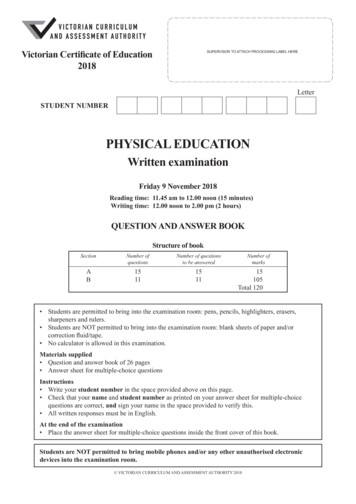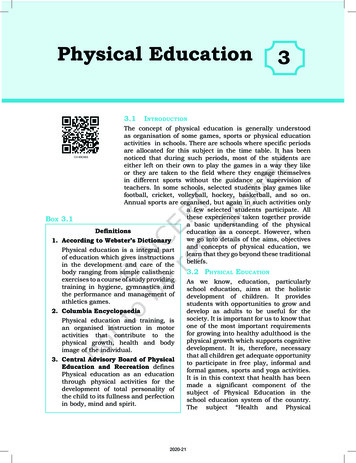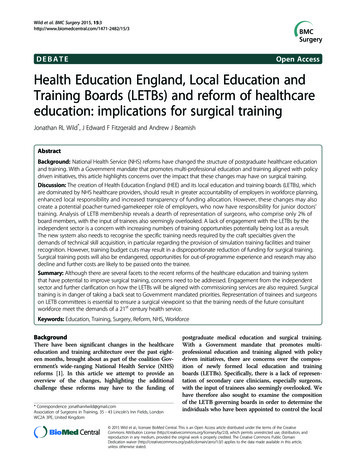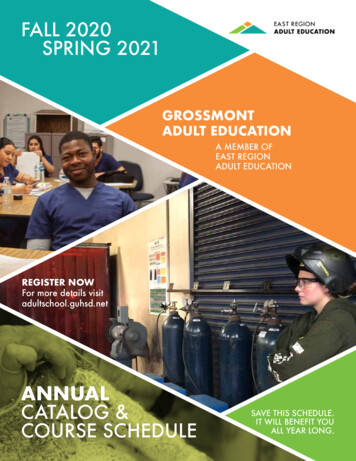
Transcription
The Praxis Study CompanionPhysical Education:Content Knowledge5091www.ets.org/praxis
Welcome to the Praxis Study CompanionWelcome to The Praxis Study CompanionPrepare to Show What You KnowYou have been working to acquire the knowledge and skills you need for your teaching career. Now you areready to demonstrate your abilities by taking a Praxis test.Using the Praxis Study Companion is a smart way to prepare for the test so you can do your best on test day.This guide can help keep you on track and make the most efficient use of your study time.The Study Companion contains practical information and helpful tools, including: An overview of the Praxis tests Specific information on the Praxis test you are taking A template study plan Study topics Practice questions and explanations of correct answers Test-taking tips and strategies Frequently asked questions Links to more detailed informationSo where should you start? Begin by reviewing this guide in its entirety and note those sections that you needto revisit. Then you can create your own personalized study plan and schedule based on your individual needsand how much time you have before test day.Keep in mind that study habits are individual. There are many different ways to successfully prepare for yourtest. Some people study better on their own, while others prefer a group dynamic. You may have more energyearly in the day, but another test taker may concentrate better in the evening. So use this guide to develop theapproach that works best for you.Your teaching career begins with preparation. Good luck!Know What to ExpectWhich tests should I take?Each state or agency that uses the Praxis tests sets its own requirements for which test or tests you must take forthe teaching area you wish to pursue.Before you register for a test, confirm your state or agency’s testing requirements at www.ets.org/praxis/states.How are the Praxis tests given?Praxis tests are given on computer. Other formats are available for test takers approved for accommodations (seepage 36).The Praxis Study Companion2
Welcome to the Praxis Study CompanionWhat should I expect when taking the test on computer?When taking the test on computer, you can expect to be asked to provide proper identification at the testcenter. Once admitted, you will be given the opportunity to learn how the computer interface works (how toanswer questions, how to skip questions, how to go back to questions you skipped, etc.) before the testing timebegins. Watch the What to Expect on Test Day video to see what the experience is like.Where and when are the Praxis tests offered?You can select the test center that is most convenient for you. The Praxis tests are administered through aninternational network of test centers, which includes Prometric Testing Centers, some universities, and otherlocations throughout the world.Testing schedules may differ, so see the Praxis web site for more detailed test registration information at www.ets.org/praxis/register.The Praxis Study Companion3
Table of ContentsTable of ContentsThe Praxis Study Companion guides you through the steps to success1. Learn About Your Test.5Learn about the specific test you will be taking2. F amiliarize Yourself with Test Questions.9Become comfortable with the types of questions you’ll find on the Praxis tests3. Practice with Sample Test Questions. 13Answer practice questions and find explanations for correct answers4. Determine Your Strategy for Success. 20Set clear goals and deadlines so your test preparation is focused and efficient5. Develop Your Study Plan. 23Develop a personalized study plan and schedule6. Review Study Topics. 27Detailed study topics with questions for discussion7. Review Smart Tips for Success. 34Follow test-taking tips developed by experts8. Check on Testing Accommodations. 36See if you qualify for accommodations that may make it easier to take the Praxis test9. Do Your Best on Test Day. 37Get ready for test day so you will be calm and confident10. Understand Your Scores. 39Understand how tests are scored and how to interpret your test scoresAppendix: Other Questions You May Have . 41The Praxis Study Companion4
Step 1: Learn About Your Test1. Learn About Your TestLearn about the specific test you will be takingPhysical Education: Content Knowledge (5091)Test at a GlanceTest NamePhysical Education: Content KnowledgeTest Code5091Time2 hoursNumber of Questions120FormatSelected-response questionsTest DeliveryComputer deliveredContent CategoriesApproximateNumber ofQuestionsApproximatePercentage ofExaminationI.IVIContent Knowledge and Student Growthand Development3630%II.Management, Motivation, and30Communication25%IIIIII. Planning, Instruction, and StudentIIAssessmentIV. Collaboration, Reflection, and Technology3025%2420%About This TestThe content knowledge test in Physical Education is designed to measure the professional knowledge ofprospective teachers of physical education in elementary through senior high schools. Examinees typicallyhave completed, or are about to complete, a bachelor’s degree program in physical education, exercise science,or similar program of study. The test assesses whether an examinee has the knowledge and competenciesnecessary for a beginning teacher of physical education. The content of the test is based largely on the teacherpreparation standards created by the Society of Health and Physical Educators (SHAPE America), formerly theAmerican Alliance of Health, Physical Education, Recreation and Dance (AAHPERD).The 120 selected-response questions cover knowledge of fitness, kinesiology, exercise physiology, fundamentalmovements, and sports that comprise the content of physical education classes; knowledge of areas in thenatural and social sciences that provide the foundation for teaching these activities; and knowledge of crucialtopics in health and safety. Knowledge of these subject areas enables teachers to understand the natureand purpose of the activities in the physical education curriculum, to evaluate and interpret the physicalcharacteristics and performances of students in physical education classes, and to make decisions about theongoing conduct of physical education classes and the needs of students in those classes. Questions will testknowledge of essential facts, including the meaning of terms and placement of content elements in propercategories, understanding of relationships between and among areas of content, and the ability to applyconcepts appropriately. This test may contain some questions that will not count toward your score.The Praxis Study Companion5
Step 1: Learn About Your TestTest SpecificationsTest specifications in this chapter describe the knowledge and skills measured by the test. Study topics to helpyou prepare to answer test questions can be found on page 27.I.Content Knowledge and Student Growthand DevelopmentA.1.2.3.4.B.1.Sequential and developmentally appropriatelearning and practice opportunities based ongrowth and motor development stages,individual characteristics and individual needs ofstudents, learning environment, and task2.Monitoring of individual performance and groupperformance in order to design safe instructionthat meets students’ developmental needs in thepsychomotor, cognitive, and affective domains3.Developmental readiness to learn and refinemotor skills and movement patterns (e.g.,biological, psychological, sociological,experiential, environmental)4.Perception in motor development5.Appropriate and effective instruction related tostudents’ cultures and ethnicities, personal values,family structures, home environments, andcommunity values6.Use of appropriate professional support servicesand resources to meet students’ needsCore ConceptsTerminology, principles, concepts, andapplications of the basic sciences as related tomotor skills and movement activities (e.g.,anatomy and physiology, exercise physiology,biomechanics and kinesiology, motordevelopment and motor learning)Principles of biomechanics and kinesiology asthey relate to motor skills and movementpatterns (e.g., summation of forces, center ofgravity, force/speed relations, torque)Movement concepts (e.g., body awareness,spatial awareness, effort, relationship)Exercise physiology (e.g., components of healthrelated fitness; components of skill-related fitness;fitness guidelines, such as frequency, intensity,time/duration, type/mode; principles of exercise,such as specificity, overload, progression; roles ofbody systems in exercise; short- and long-termeffects of physical training; nutrition as related toexercise; fitness; metabolic response to exercise)5.Anatomy and physiology (e.g., skeletal, muscular,nervous, circulatory, and respiratory systems)6.Current and historical trends, issues, anddevelopments in physical education (e.g., laws,teaching methods, theories, concepts,techniques)7.Understanding of the rules, strategies, skills,techniques, and concepts associated with avariety of movement activities and games acrossthe age and grade spectra; emphasispredominantly on softball, soccer, swimming,tennis, track and field, and volleyball, withquestions based possibly on other sports andactivities commonly used in physical educationsettings8.Liability and legal considerations pertaining tothe use of equipment, class organization,supervision, and program selection9.Effects of substance abuse on studentperformance, health, and behaviorThe Praxis Study CompanionStudent Growth and Development6
Step 1: Learn About Your TestII.Management, Motivation, andCommunicationA.Management and Motivation1.Principles of classroom management practicesthat create effective learning experiences inphysical education settings2.Psychological and social factors that affectindividual learning and group learning,participation, cooperation, and performance inphysical education settings3.Organization, allocation, and management ofresources to provide active and equitablelearning experiences (e.g., time, space,equipment, activities, teacher attention, students)III.Planning, Instruction, and StudentAssessmentA.Planning and Instruction1.Teaching of skillful movement, physical activity,and fitness via pedagogy, sociology, psychology,anatomy and physiology, exercise physiology,biomechanics and kinesiology, motordevelopment and motor learning2.Sequencing of motor skill activities and use ofmovement concepts and effective strategies toimprove learning in physical education activitiesand to improve skill development3.Provision of feedback to enhance skilldevelopment4.Motivation of students to participate in physicalactivity both in school and outside of school4.Activities designed to improve health-related andskill-related fitness5.Promotion of positive relationships,encouragement of responsible personal andsocial behaviors among students, andestablishment of a productive learningenvironment5.Current issues, trends, and laws affecting thechoice of appropriate physical educationactivities6.Identification, development, and implementationof appropriate program and instructional goalsand objectives7.Development of unit and lesson plans based onlocal, state, and national standards, programgoals, instructional goals, and students’ needs8.Appropriate instructional strategies to facilitatelearning in the physical activity setting based onselected content, students’ needs, safetyconcerns, facilities and equipment, andinstructional modelsUse of teaching resources and curriculummaterials to design learning experiences6.B.1.Development and use of an effective behaviormanagement planCommunicationEffective verbal and nonverbal communicationskills in a variety of physical activity settings2.Specific appropriate instructional feedback in skillacquisition, student learning, and motivation3.Communication of classroom management andinstructional information in a variety of ways (e.g.,verbally and nonverbally and via bulletin boards,music, task cards, posters, technology)9.Communication in ways that show respect andconsideration for students, colleagues, andparents10. Explanations, demonstrations, and appropriateinstructional cues and prompts to link physicalactivity concepts to learning experiences and tofacilitate motor skill performance4.11. General and specific safety and injury preventionguidelines for planning of movement and fitnessactivities (e.g., first aid, cardiopulmonaryresuscitation)B.The Praxis Study CompanionStudent Assessment1.Assessment of student skill performance andfitness via a variety of tools (e.g., observations,data, charts, graphs, rating scales)2.Gathering of data and assessment of studentlearning in the cognitive and affective domainsby a variety of techniques (e.g., writtenassessments, rating scales, observations)7
Step 1: Learn About Your Test3.Understanding of fitness assessments such asPresident’s Challenge and Fitnessgram4.Types of assessments and assessment methods(e.g., formative, summative, authentic, portfolio,standardized, rubric, criterion referenced, normreferenced)5.Validity, reliability
The Praxis Study Companion 5 Step 1: Learn About Your Test 1. Learn About Your Test Learn about the specific test you will be taking Physical Education: Content Knowledge (5091)
